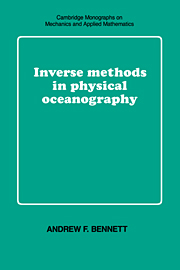Book contents
- Frontmatter
- Contents
- Preface
- 1 Finite-dimensional inverse theory
- 2 The smoothing of observations
- 3 Data assimilation
- 4 The spatial structure of the Kalman filter
- 5 Generalized inverses of dynamical models
- 6 Antenna analysis
- 7 Nonlinear quasi-geostrophic models
- 8 Open-ocean modelling: quasi-geostrophy
- 9 Primitive-equation models
- 10 Outstanding problems
- Bibliography
- Subject index
4 - The spatial structure of the Kalman filter
Published online by Cambridge University Press: 08 January 2010
- Frontmatter
- Contents
- Preface
- 1 Finite-dimensional inverse theory
- 2 The smoothing of observations
- 3 Data assimilation
- 4 The spatial structure of the Kalman filter
- 5 Generalized inverses of dynamical models
- 6 Antenna analysis
- 7 Nonlinear quasi-geostrophic models
- 8 Open-ocean modelling: quasi-geostrophy
- 9 Primitive-equation models
- 10 Outstanding problems
- Bibliography
- Subject index
Summary
Spatial structure
The Kalman filter (KF) was originally developed for simple dynamical systems, such as the few ordinary differential equations representing the motion of a projectile. Ocean models are represented by partial differential equations, which are equivalent to infinite systems of ordinary differential equations. These are known as “distributed parameter systems” in the engineering literature (e.g., Aziz, Wingate & Balas, 1977). There is a question of convergence, equivalent to determining whether the KF estimate of the state (here, the ocean circulation) is physically realizable. Unsatisfactory estimates are obtained even at modest spatial resolution if realizability conditions are not met. Typically, the estimates are strongly influenced by the data only in the immediate neighborhood of the measurement site. In that case, the approximate estimation procedure has served little purpose. The range of influence of the data is correctly determined by the scales of the dynamics and also those of the system noise covariance. A small range may be the consequence of realistic choices for the scales, in which case even exact KF estimation would serve little purpose. The objective of this section is to analyze the relationship between the range of influence of the data (that is, the spatial scales of the Kalman gain) and the scales of the dynamics, the system noise, and, to a lesser extent, the initial noise. The discussion follows Bennett & Budgell (1987, 1989).
To expedite the analysis of scales, the single-layer quasi-geostrophic model (3.3.1) will be used in conjunction with the choice (i) for boundary conditions, namely, periodicity of all fields in the x-and y-directions.
- Type
- Chapter
- Information
- Inverse Methods in Physical Oceanography , pp. 90 - 111Publisher: Cambridge University PressPrint publication year: 1992



